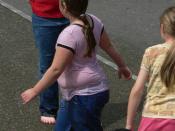Imagine a bucket of chicken, half a pizza, a Kid's Meal from McDonald's, and a large Cola. It sounds like there is enough food to feed at least a dozen people, right? Now imagine all that food going only into one mouth, in one sitting. The mouth belonging to a six-year-old girl weighing 70 pounds, who does not want to go out and play, only wanting to watch TV or play video games. How did this child develop these eating habits? What will become of this child? What kind of measures can help this child? Due to the rising epidemic of childhood obesity, especially in young girls, it is important to address the underlying causes, effects, and preventative measures of childhood obesity.
Childhood ObesityNo general agreement exists on the definition of obesity in children as it does adults. "Most professionals use published obesity guidelines that use the body mass index (BMI), or a modified BMI for age, as a measure of obesity for children.
Others define obesity in children as body weight at least 20% higher than a healthy weight for a child of that height or a body fat percentage of more than 25% in boys and 32% in girls" (Alliance For a Healthier Generation, 2005). According to a nurse who teaches at the University of Michigan, "obesity means having too much body fat" (Boyse, 2007). As registered nurse Boyse (2007) appropriately phrased it, "a child is obese if their weight is more than 20% higher than the ideal weight for a boy or girl of their age and height." For example, a six-year-old girl who is 42 inches tall and weighs 70 pounds would be considered obese. How did this child come to weigh as much as she does? There is a variety of circumstances that could...


